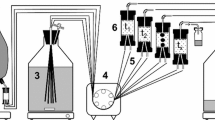Abstract
The use of oxygen releasing solids in passive wells has become of considerable interest in the bioremediation of groundwater contaminated with hydrocarbons and other biodegradable contaminants. Labor, operating, and maintenance costs of this technology are quite competitive with more conventional techniques in many instances. Because of the small rates of mass transport by transverse dispersion, however, a pin-stripe pattern of alternating contaminant and oxygen distribution is expected downgradient of a line of wells which is unacceptable if it extends beyond the point of compliance downgradient. A mathematical model is presented which permits determination of the maximum well spacing in an array of wells which will yield effective remediation within a specified distance of a plume of contaminated groundwater passing through the array. Transverse dispersion of both oxygen and the contaminant is assumed, and biodegradation is modeled by means of Monod kinetics. Longitudinal numerical dispersion is minimized by the use of a asymmetrical upwind algorithm for modeling advection. Modeling results are presented showing the dependence of model behavior on input parameters.
Similar content being viewed by others
References
Brown, R. A., Hinchee, R. E., Norris, R. D. and Wilson, J. T.: 1996, ‘Bioremediation of Petroleum Hydrocarbons: A Flexible, Variable Speed Technology’, Remediation, Summer 1996, p. 95.
Chapman, S. W., Byerly, B. T., Smyth, D. J., Wilson, R. D. and Mackay, D. M.: 1997, ‘Semipassive Oxygen Release Barrier for Enhancement of Intrinsic Bioremediation’, in In Situ and On-Site Bioremediation: Vol. 4, 4th International In Situ and On Site Bioremediation Symposium, New Orleans, LA, Apr. 28 – May 1, B. C. Alleman and A. Leeson, symposium chairs, Battelle Press, Columbus, OH, p. 209.
Charbeneau, R. J., Bedient, P. B. and Loehr, R. C.: 1992, Groundwater Remediation, Technomic Publishing Co., Lancaster, PA.
de Marsily, G.: 1986, Quantitative Hydrogeology: Groundwater Hydrology for Engineers, Academic Press, New York, p. 238.
Heitkamp, M. A.: 1997, ‘Effects of Oxygen-Releasing Materials on Aerobic Bacterial Degradation Processes’, Bioremediation Journal, 1(2), 105.
Hinchee, R. E.: 1994, Air Sparging for Site Remediation, Lewis Publishing Co., Ann Arbor, MI.
Hinchee, R. E., Miller, R. N. and Johnson, P. C.: 1995, In Situ Aeration: Air Sparging, Bioventing, and Related Remediation Processes, Battelle Press, Columbus, OH.
Johnson, J. G. and Odencrantz, J. E.: 1997, ‘Management of a Hydrocarbon Plume Using a Permeable ORCTM Barrier, in In Situ and On-Site Bioremediation: Vol. 4, 4th International In Situ and On Site Bioremediation Symposium, New Orleans, LA, Apr. 28 – May 1, B. C. Alleman and A. Leeson, symposium chairs, Battelle Press, Columbus, OH, p. 215.
Koenigsberg, S., Sandefur, C. and Cox, W.: 1997, ‘The Use of Oxygen Release Compound (ORCTM) in Bioremediation, in In Situ and One-Site Bioremediation: Vol. 4, 4th International In Situ and On Site Bioremediation Symposium, New Orleans, LA, Apr. 28 – May 1, B. C. Alleman and A. Leeson, symposium chairs, Battelle Press, Columbus, OH, p. 247.
Levine, I. N.: 1988, Physical Chemistry, 3rd ed., McGraw-Hill, New York, p. 484.
Lyman, W. J., Noonan, D. C. and Reidy, P. J.: 1990, Cleanup of Petroleum Contaminated Soils at Underground Storage Tanks, Noyes Data Corp., Park Ridge, NJ.
National Research Council: 1994, Alternatives for Groundwater Cleanup, National Academy Press, Washington, D.C.
Scheidegger, A. E.: 1974, The Physics of Flow through Porous Media, University of Toronto Press, Toronto, Ont., Canada.
Thibodeaux, L.: 1996, Environmental Chemodynamics, 2nd ed., Wiley-Interscience, New York, NY.
U. S. EPA: 1996, Pump-and Treat Ground-Water Remediation: a Guide for Decision Makers and Practitioners, EPA report no. EPA/625/R-95/005.
Ward, C. H., Loehr, R. C., Nyer, E. K., Piotrowski, M. R., Thomas, J. M., Spain, J. C., Wilson, J. T. and Norris, R. D.: 1995, Innovative Site Remediation Technology, vol 1: Bioremediation, American Academy of Environmental Engineers, Annapolis, MD.
Wilson, D. J. and Clarke, A. N.: 1994, Hazardous Waste Site Soil Remediation: Theory and Application of Innovative Technologies, Marcel Dekker, New York, NY.
Wilson, D. J.: 1995, Modeling of In Situ Techniques for Treatment of Contaminated Soils: Soil Vapor Extraction, Sparging, and Bioventing, Technomic Publishing Co., Lancaster, PA.
Wilson, R. D. and Mackay, D.M.: 1997, ‘Arrays of UmpumpedWells for Plume Migration Control or Enhanced Intrinsic Remediation’, in In Situ and On-Site Bioremediation: Vol. 4, 4th International In Situ and On Site Bioremediation Symposium, New Orleans, LA, Apr. 28 – May 1, B. C. Alleman and A. Leeson, symposium chairs, Battelle Press, Columbus, OH, p. 187.
Wilson, R. D., Mackay, D.M. and Cherry, J. A.: 1997, ‘Arrays of Unpumped Wells for Plume Migration Control by Semi-Passive In Situ Remediation’, Ground Water Monitoring and Remediation, 17, 185.
Author information
Authors and Affiliations
Corresponding author
Rights and permissions
About this article
Cite this article
Norris, R.D., Wilson, D.J. & Chang, E. Bioremediation With Oxygen-Releasing Solids: A Mathematical Model. Environ Monit Assess 58, 243–281 (1999). https://doi.org/10.1023/A:1006025132709
Issue Date:
DOI: https://doi.org/10.1023/A:1006025132709




